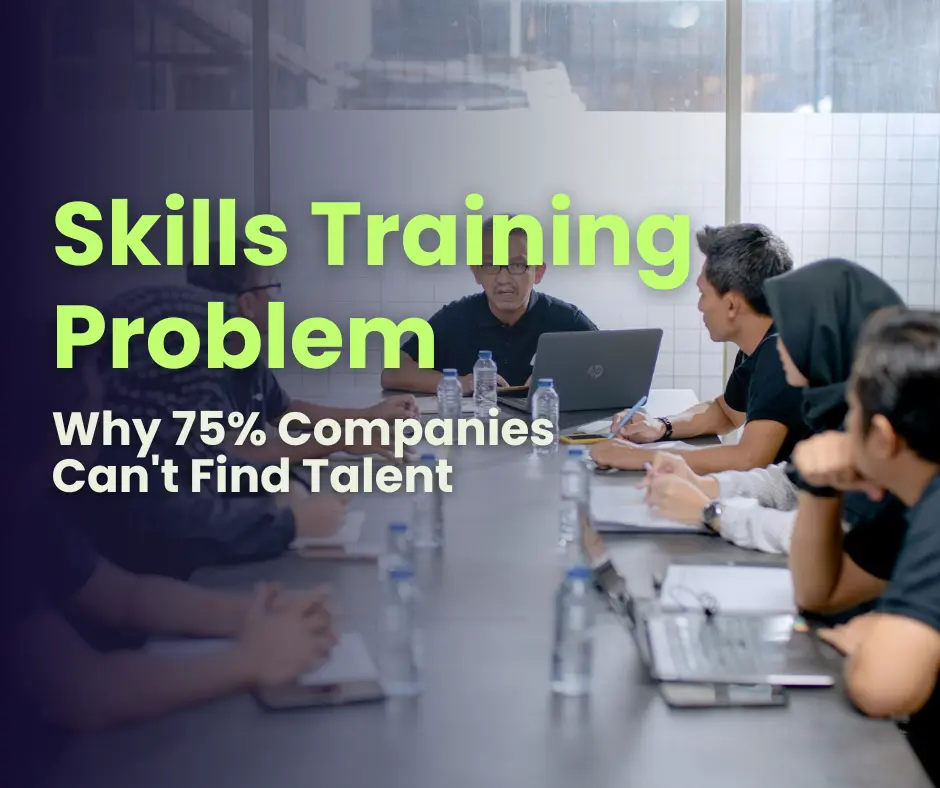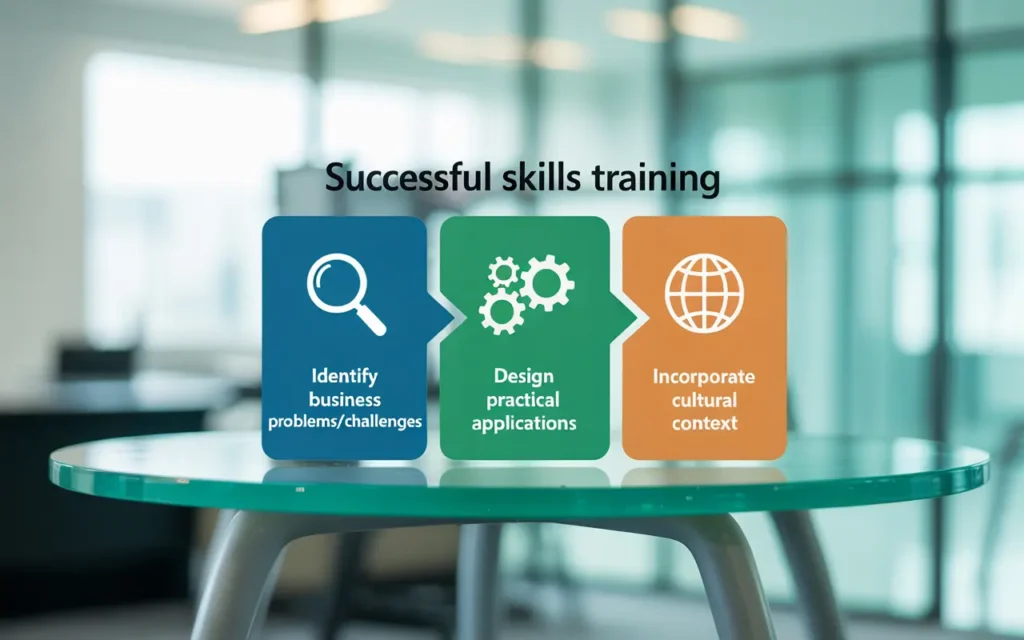
Your last skills training program probably didn’t work.
If you’re like most business leaders I talk to across Malaysia, Singapore, Thailand, and Indonesia, you spent thousands on training last year and still can’t find people with the right skills. Your team completed the courses, got their certificates, and went right back to doing things the old way.
Here’s the uncomfortable truth: 75% of companies can’t find skilled talent, but it’s not because there aren’t enough people. It’s because most skills training is broken from the start.
After helping dozens of Southeast Asian businesses transform their approach to AI and digital skills, I’ve seen what actually works and what’s just expensive theater.
Why Your Current Skills Training Isn’t Working
Let me guess what happened with your last training program:
You picked a popular provider, sent your team to a workshop (or enrolled them in online courses), they came back excited for about a week, then nothing changed in how they actually work.
Sound familiar?
The problem isn’t your team’s motivation. It’s that most skills training programs are designed wrong from day one.
- They focus on features, not outcomes. Your team learns how to use ChatGPT, but they don’t know how to use it to solve the specific problems they face every day in your business.
- They ignore cultural context. Training designed for Silicon Valley startups doesn’t work for hierarchical Southeast Asian businesses where decisions flow top-down and harmony matters more than individual achievement.
- They measure the wrong things. Completion rates and test scores don’t matter if nothing changes in your business operations.
- They treat everyone the same. Your CFO doesn’t need the same AI training as your marketing coordinator, but most programs pretend that one-size-fits-all works.
What Actually Drives Results in Skills Training
After working with companies from small Malaysian SMEs to large Thai corporations, I’ve identified what separates successful skills training from expensive mistakes.
Start with business problems, not technologies.
The best skills training I’ve designed begins with questions like “How can we reduce our customer response time?” or “What’s stopping us from scaling faster?” Then we work backward to the specific skills needed to solve those problems.
Make it immediately applicable.
Instead of learning AI theory, your team learns to build the exact prompts they’ll use for vendor evaluations, customer service responses, or market research. They walk away with tools they can use tomorrow.
Design for your culture.
In Southeast Asian businesses, group learning with senior leadership involvement works better than individual online courses. When the CEO participates in AI training, the rest of the organization takes it seriously.
Focus on microlearning.
Your executives don’t have time for week-long workshops. But they can absorb 15-minute modules during their commute or between meetings. Research shows this approach delivers 60% better retention anyway.

The Skills Training Framework That Works
Here’s the framework I use with clients that consistently delivers results:
1. Map Skills to Business Outcomes
Before any training happens, we identify exactly how each skill connects to measurable business improvements. For example:
- Learning advanced Excel → Reducing monthly reporting time by 50%
- Mastering AI tools → Improving proposal quality and win rates
- Understanding data analytics → Making faster, more accurate inventory decisions
2. Create Industry-Specific Applications
Generic training fails because it doesn’t connect to your reality. Instead, we build training around your actual business scenarios:
- For FMCG companies: AI for demand forecasting and consumer behavior analysis
- For logistics firms: Route optimization and predictive maintenance
- For financial services: Risk assessment and regulatory compliance automation
- For manufacturing: Quality control and supply chain optimization
3. Build in Cultural Context
Skills training in Southeast Asia needs to respect how decisions actually get made in your organization:
- Senior management involvement signals importance to the entire team
- Group-based learning builds consensus and reduces resistance to change
- Face-to-face components build the relationships that make implementation successful
- Clear hierarchies in training delivery match your organizational structure
4. Design for Immediate Implementation
Every training session ends with participants creating something they’ll use in their actual work within 48 hours. No exceptions.
This might be building an AI prompt for their customer service team, creating a data dashboard for their department, or designing a workflow automation for a repetitive task.
The AI Skills Training Opportunity
Here’s what most business leaders don’t realize: AI skills training isn’t just about keeping up with technology. It’s about fundamentally improving how your business operates.
The companies I work with see results like:
- 40% reduction in time spent on routine tasks
- 25% improvement in decision-making speed
- 60% faster customer response times
- 30% better accuracy in forecasting and planning
But here’s the key: these results only happen when skills training is designed for your specific business context and challenges.
What to Look for in Skills Training Partners

Not all training providers understand Southeast Asian business environments. Here’s what separates the good from the mediocre:
They ask about your business challenges first, not what technologies you want to learn. The right training partner spends more time understanding your operations than pitching their curriculum.
They have regional experience. Training that works in Singapore’s business environment needs different approaches than what works in Indonesia or Thailand. Cultural context matters.
They measure business impact, not just completion rates. Ask prospective training partners how they track whether participants actually apply what they learn. If they can’t answer, keep looking.
They provide ongoing support. Skills training isn’t a one-time event. The best programs include follow-up sessions, peer learning groups, and implementation support.
Getting Started with Effective Skills Training
If you’re ready to move beyond training theater to programs that actually drive business results, start here:
Identify your biggest operational pain points. Where is your team spending too much time on routine work? Where are you making decisions based on gut feeling instead of data? These are your skills training opportunities.
Start small and specific. Instead of company-wide transformation programs, begin with one department and one clear business challenge. Build success stories you can scale.
Involve senior leadership. Skills training works when it’s seen as a strategic business investment, not an HR requirement. Your participation signals importance to everyone else.
Focus on application, not theory. Every training session should produce something your team will actually use in their daily work.
The Bottom Line on Skills Training
The skills gap isn’t going away. Technology keeps advancing, customer expectations keep rising, and competition keeps intensifying.
But throwing money at generic training programs won’t solve your talent challenges. You need skills training designed for your business, your culture, and your specific operational needs.
The companies that get this right don’t just fill skill gaps they build competitive advantages. They make faster decisions, serve customers better, and operate more efficiently than competitors still struggling with one-size-fits-all training approaches.
The question isn’t whether you need better skills training. It’s whether you’re ready to invest in programs that actually work.
Ready to design skills training that drives real business results? Let’s discuss how to build AI capabilities that solve your specific operational challenges. Book a strategy consultation to explore customized training frameworks for your Southeast Asian business context.

